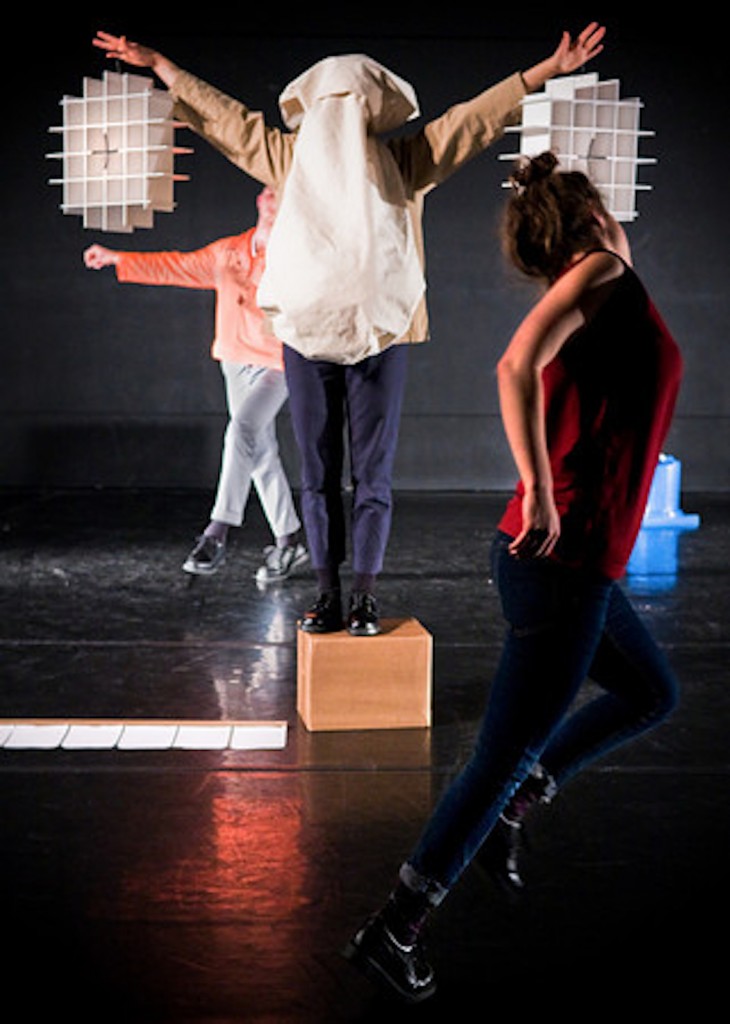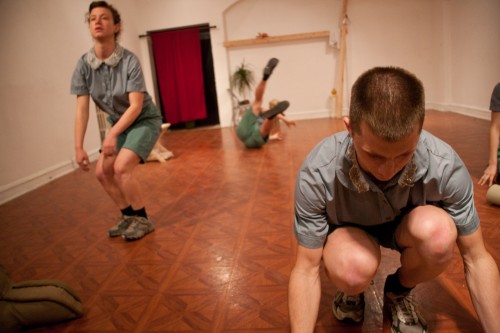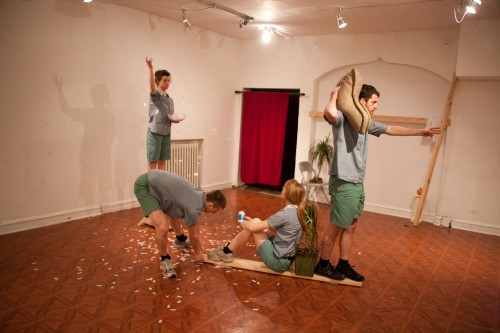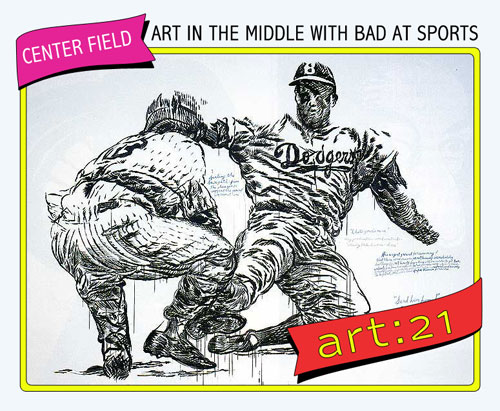I am always amazed by the effect of performance, particularly the ways in which a single, cohesive piece (often comprised of abstract, sequential movements) emerges from a group. It’s a little like watching a magic trick—seeing a woman cut in half with a saw without understanding how the illusion of her bisection is possible. Millie Kapp creates similar illusionary spaces—spaces of theater and spectacle in which words are inessential; the body is the text— a vehicle for expression—and auxiliary props become equal bodies. Recently she has been working with a collaborative group called Husband. In the following interview we talk about the process of building a performance, the way she interacts with material and the group she works with.
Caroline Picard: How did your collaborative performance group start?
Millie Kapp: In February of 2012, Annie Maurer, Matt Shalzi, and Noah Furman and I began our fourth piece together. At this time we decided to make the parameters and commitment of our group official with a name. After months of snowballing free associations, we decided on the name Husband. We named ourselves after a prop we’d used in 2011, a husband pillow, that played a particularly integral part in the performance, The palm poises as a plant does and slips into the evening of the day. Through play-based experimentation, the husband pillow shifted meaning and took on layered significances as it performed as body, face, machine, and mirror [over the course of the performance]. These kinds of shifts and layers are things we try to do with most of our movement, text, and objects.

Husband, "A Face on the Doorway." Still from performance, DanceBridge Showcase, 2011. Photo by John Sisson.
The first work that we did together was in 2010 entitled, Waiting for tonight: Waiting for tonight. This piece was performed at Sullivan Galleries. We subsequently made The palm poises as a plant does and slips into the evening of the day and performed this work at the Archer Ballroom, Links Hall, Roxaboxen Exhibitions, and the 9×22 Bryant Lake Bowl in Minneapolis, MN. In fall 2011 we made A Face in the Doorway, and showed this work at the Chicago Cultural Center and the Clemente Soto Vélez Cultural Center in New York. Recently, we showed The hidden woods in the conversation at Alderman Exhibitions. It was not until recently however, that Husband became an official collective. We needed to work together for a few years before such a commitment!
CP: Can you talk a little about how you build up a piece? Where do you begin, and how it comes together?
MK: We begin by establishing two key elements for the rehearsal process, first, source material and second, the organization of roles and responsibilities for the project. For the most recent project, The hidden woods in the conversation, our source material was the German romantic text On Marionette Theatre by Heinrich Von Kleist. Von Kleist praises the inanimate, un-self-conscious marionette as a more graceful dancer than the self-conscious, contrived human. In response, we created and performed movement for one another while observing how and to what degree our own levels of self-consciousness changed.
The second thing we decide is the varying roles and tasks we plan to take on during the rehearsal process. We find new ways to shape and play with types of responsibility. In The hidden woods in the conversation, we decided that Noah, Annie and I would take turns acting as director and lead rehearsals that responded to the Von Kleist text. Matt prepared different warm-up activities and prompts for each section.
Each new project brings the opportunity to respond to past projects. In our director roles, we are free to prompt the others in whatever inquiries and mediums we wish. Noah had us making paintings, in my section, a play was produced and in Annie’s section, we made movement that explored themes of display and hiding. We intend to create a space for each other’s curiosities to be explored and in order to do so we find sources and structures of collaboration to contain these varying focal points.

Husband, "The palm poises as a plant does and slips into the evening of the day." Still from performance, 2011. Photo by John Sisson.
CP: How do you think about the body-as-material?
MK: We are totally fascinated by the materiality of the body, the body as object, or as equal to objects, as well as the textures and visual qualities of moving bodies. Though we have these interests, we arrive at them through totally cognitive and critical processes. The physicality of the performance never stands on its own formal grounds–there are often emotional and linguistic dynamics that set off a purely physical exploration. The improvisation we use to explore the materiality of the body exists always in relation to objects, images, language and concepts. The failure to fully abstract bodies in space has always fascinated me. Our work aims to present the-body-as-material and in the same breath, the reverberating associative, conceptual, and emotional experiences of watching another person do things.
CP: That reminds me of a tennis court performance I saw that you and Isabelle Ng directed in 2009, a bob ross song, an orson welles trick—obviously it was before you started collaborating as Husband, but I was struck by the way you used the tennis court as a formal, aesthetic landscape. You also had these long painted, plywood boxes out of which someone’s legs, or head would be visible. Allen and Michael Fleming did a dance on either side of the net—like mirror images of one another—and then someone else sang a song occasionally from the sidelines. Somehow I feel like everything—the material boxes (especially as hybrid humans), the dancers, the human voice and the tennis court flattened out. How did that composition come together? How did the emotional experience that you mention relate to, or bump up against, the abstract experience of the tableau?
MK: A bob ross song, an ors0n welles trick was a work made in response to Version Fest 9’s call for site-specific performances. We had never made a site-specific performance and were excited to try our hand at it. We decided to do something large scale with many performers. There were thirteen performers and three sources we were creatively responding to, first a tennis court, second footage from an Orson Welles magic trick, and three Bob Ross painting instructions. The performance was structured by a score derived from twenty minutes of Bob Ross painting instructions and a three-part Orson Welles magic trick re-enactment. Instead of producing a painting from Bob Ross’s instructions, we used his commands as direction for movement. Similarly, we used Orson Welles’ trick as a structuring device that broke up the performance in three ways. The first phase of the trick presents the ordinary, what seems to be a human body trapped in a box. The second phase of the trick presents a problem, the box that appeared whole is split in two and in each half of the box there is half a living body. The third phase of the trick is the resolve, when the half bodies in the boxes come back together and appear to be a new whole again.
In A bob ross song, an orson welles trick, scale was essential in creating a spectacle, a spectacle that totally repurposed the tennis court as a space for re-enactment, dance, and “magic.” Like other work I’ve made, it was born of unexpected relationships between dissimilar elements. The qualities of our three sources, Bob Ross, Orson Welles, and a tennis court, came together to create a transcendent experience. I think an emotional experience was produced during this performance, though I wasn’t as intent then as I now am about constructing varying tempos and textures of emotional affect.
CP: I’m always amazed by the way you consider props and costumes—where does that come from?
MK: [Husband’s] approach to props, costumes and sound mostly stems from the work and what the work seems to need. When I first started making performances, the work was more calculated and premeditated — I usually had a few ideas about objects and costumes before beginning the rehearsal process. Since The Palm in 2011, we’ve mostly abandoned that method. I find that the more we listen to the demands of the material we generate in rehearsal, the more complex and multifaceted the uses of the objects become.
Another aspect of our aesthetic is the highly precise timing of events and action that structure the performance. This strategy we owe to Goat Island. Their commitments to chance operations and rigid temporal scores have been influential. We conduct experiments within time segments that are often reassembled, reduced or elongated to shape an experience of time. We use timing formally not only to guide our rehearsal explorations, but also to guide an audience member’s experience of the final performances. This precision allows us to explore wide-open play, and similarly might permit an audience member to follow us into territories where meaning is not stable.
We are also interested in dealing with actions and objects that register on different levels of familiarity and signify varying kinds of labor. Matt might build an archway that is distinctly not of this world, but will perform alongside the archway in a Chicago Bulls hat, something more banal or familiar. Choreographically speaking, we are interested in composing highly specific dance sequences that are derived from half time show choreography, and in the same breath improvise violent pseudo-slapstick movements. There is no hierarchy of invention or interpretation. Art objects and everyday mass-produced items, the idiosyncratic and the familiar exist as elements on a level playing field.

Husband, "The palm poises as a plant does and slips into the evening of the day." Still from performance, 2011. Photo by John Sisson.
CP: What is the difference between sound and movement, as far as devices that you use in performance, for you?
MK: Sound is an aspect of the work that gets me very excited. Since our work exists mostly in the form of movement, I love playing with the trope of song and dance. We have dealt with sound in a variety of ways. We have commissioned musicians, played music videos, and sang ourselves. We have also made performances without music and allowed the rhythms of action to act as a soundtrack for the work. In our most recent project, The hidden woods in the conversation, we used a Sonic Youth instrumental song as a way to keep time. The song delineates a section of the performance in which all actions are in some way hidden. This song sounds like generic 90s rock and when played, sets up a contrast between the ambiguous hidden movements and the booming presence of rock and roll.
CP: I was also thinking about the way you incorporate the human voice—I remember in The palm poises as a plant does, and slips into the evening of the day performers were mostly quiet throughout the piece. Then suddenly you screamed. It was incredibly effective. I kept thinking about the function of your voice, flanked by voice-less-ness. What was it like breaking the silence at that moment? How did it compare with any directorial expectations that made a voice/a cry necessary? Was that an abstract decision or an emotional one?
MK: The Palm was a huge turning point for me in my work and I think that my “death,” the scream you are referring to, is illustrative of this change. The transformation I am taking about is a transformation of permission. When Annie became outside eye, I allowed myself to perform without worrying about the direction of the work. I could make choices as a director but never had to take on the overseeing solely by myself. This freedom allows me to genuinely play and do some really deranged things, like relish in dying. In regard to the actual performance of my death, it was exhilarating. I loved obliterating my sense of self-consciousness in an effort to channel extreme force. Oddly enough the scream was born of a small choking gesture and with the help of repetition and many laughs, the small gesture grew into an enormous freak out. Directorially, that moment is about a kind of performance that has power in its extreme physicality and resonance and as it doubly points to itself as a performance.





Pingback: When Bodies & Language & Landscape are one | The Lantern Daily